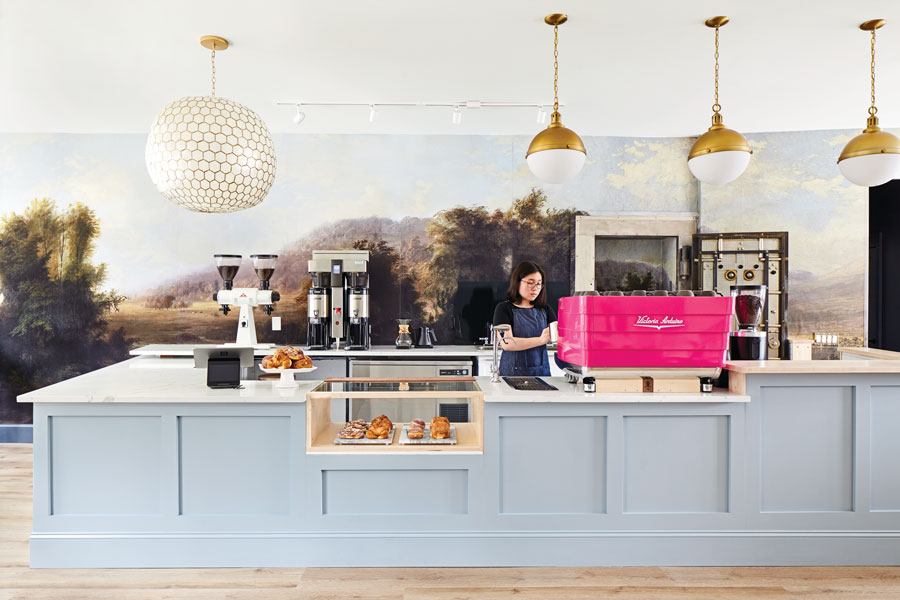How the Hell Should We Tip for Takeout?
We asked Philly-area baristas, bakers, front-of-house staff, and customers their thoughts.

The counter at Three Graces Coffee Co. in Queen Village/ Photograph by Kyle Smith Born
Everyone I know has questions about tipping etiquette these days. Sure, it’s common practice in our country to tip 20 percent after a sit-down meal. But the consensus about tipping starts to break down when takeout, coffee, and counter-service exchanges enter the chat. In a recent Forbes study that surveyed 2,000 American diners about their tipping habits, fewer than half of participants said they tip in fast-casual settings. And 38 percent of those surveyed said they don’t believe fast-casual restaurants should even ask for tips.
In Philadelphia and across the country, servers, bartenders, and support staff rely on gratuity to supplement the minimum wage for tipped employees (which is $2.83 in Pennsylvania, so long as that employee earns at least $135 in tips per month). But what about baristas, delivery drivers, ice-cream scoopers, and the people handing you a croissant at your local bakery? It’s not always clear how much these workers depend on tips or what the expectations for customers might be — so I asked. Here’s what some baristas, bakers, and other Philadelphians in and out of the restaurant industry had to say about tipping in settings beyond table or bar service.
Ed. Note: Respondents asked to be anonymous.
“Our tips depend a lot on the time of day. Brunch is a wildcard because some people are picking up [orders] and some people are paying and then sitting down. It’s why people don’t like working brunch because the tips are so inconsistent. We make the tipped minimum wage, which is $2.83, and I think a lot of people don’t understand that we are fully relying on them to make an income.” — Server at a restaurant that offers takeout and counter-service during brunch
“I tip pretty much whenever it’s offered in the food or beverage scene, especially if a place has the Square system card readers. At coffee shops or bakeries, I like the pre-set $1 to $2 options. If the screen prompt uses percentages, I’ll hit 20 percent. The same goes for online orders. To me, a tip usually comes to less than $10 for these smaller purchases, and if I am already making the choice to spend that money out, I’m prepared for that extra amount. I still am unsure if tipping is expected when I am just buying something like store merch or to-go items like beer or fancy hot sauce, and I am strictly paying for those. I often still will, but [those situations are] maybe the only times I would hit 10 to 15 percent. I probably handle it differently each time, to be honest.” — Customer
“My base pay is $10 an hour. After tips I make anywhere between $20 and $25 an hour. People tend to tip well — a lot of people really show us in a monetary way that we’re an important part of their day and routine.” — Barista at a Philly-based chain
“I was recently at a coffee shop, and I overheard a woman say ‘I’m so tired of tipping.’ And then she left nothing. She said it loudly enough, clearly on purpose, so the employees would hear. And it made me really mad. Tipping is an option. It’s one that most of us would never forgo because we know how it works when we dine out or someone makes us a latte. But it’s still an option. The fact that she felt the need to pronounce this just felt mean-spirited.” — Customer
“As a manager, I don’t take tips from customers. But for my staff who do live off tips, I can see the stress it puts on them. I really wish it was not a thing. I’ve seen one delivery driver make $80 in a shift and another driver make $120 in the same amount of time. For delivery, it’s really based on luck! We have some older customers who still think a dollar or two is enough for a person delivering their food, but, sadly, it isn’t. Truthfully, I wish we could eliminate tips all together. However, I think people would freak out if prices of food went up more. I don’t think people should default to 20 percent, but I do think you should consider how far you are from the restaurant and how much you order. We’ve had customers who have ordered catering consisting of multiple full trays of hot food (that require multiple trips up and down stairs to an office) and only leave a $5 tip, which I don’t think is right. For a normal order of food for a family, a normal tip is at least $5. Some people do tip 20 percent, which I do think is really generous when the bill gets higher.” — Second-generation manager of a family pizzeria
“At coffee shops, I always tip since the product is different based on the barista. I usually tip based on actions. If I’m ordering a cortado or a pour-over, I’ll usually tip higher based on the additional work needed. If I order a cold brew or a regular coffee, I’ll usually tip lower. I think, in the end, I’m tipping for technique.” — Customer
“As someone who has been a tipped employee, I have such a love-hate relationship. Tips are amazing as an hourly employee. They can be a lifeline at times. The moment my feelings turned is when my old employer tried to tell us that they weren’t actually paying us $15 an hour: They were paying us well over that, including our tips. They used this logic to dismiss our demand for a raise. When we then tried to demand a mandatory 20 percent tip on all transactions to make our wages set, they said this was unfair to our customers. It allowed this small business to both not pay us enough and not take any credit for it.” — Former baker
“I tip $1 per coffee and 10 percent on takeout.” — Customer
“The driving force of tipping is the feeling that you get when you tip a restaurant or a person. It’s this idea that you are a better person, that you’re giving them something. The guests won’t allow us to do automatic tipping because it removes that feeling of feeling good about yourself because you’re giving someone money.” — Manager at an all-day cafe and restaurant
“I always tip at least 20 percent. I know some folks think that’s too much for just pouring a cup of coffee or just scooping ice cream, but I know how little those jobs pay and how grueling that work can be. Additionally, you aren’t just paying for the moment of service you receive when a barista makes your cup of coffee. You’re paying for the time it took for them to grind and brew the coffee, to restock the cups, to count the till in the morning, the years of experience it took for them to learn that cute latte art, etc. Tipping is a horribly flawed system — workers should be paid a livable wage. There is no such thing as unskilled labor, after all. But, unfortunately, it’s the system we have, and throwing a few extra dollars in a tip jar or picking 20 percent on an iPad can mean the difference between grocery money and no food for someone who makes $10 per hour. Tipping is part of the cost of coffee or delivery because the people making it deserve coffee and delivery too. If it’s too expensive with a tip, don’t buy it.” — Former barista and current coffee-shop enthusiast
“I’m all for tipping generously in any and all instances where service is provided — restaurants, cafes, etc. But things have gotten a little nutty, and now we are all immediately prompted on point-of-sales system to add gratuity even where no service is provided. The idea of tipping servers is because they are not getting paid.” —Customer
“Tipping is essentially a bonus for a service provided. If a barista makes me a beautiful latte, I’m happy to add a dollar. If they hand me a pre-made muffin in a bag and the screen is still prompting me for a tip? Ehhh, it feels manipulative. The whole idea of the barista industry was the knowledge that you got a higher pay but fewer tips, and that was a choice you consciously made between barista life and waiter life, each with its pros and cons. We’re also dealing with lower overhead, and general labor and food costs at coffee shops — like, just fucking raise your coffee from $5 to $6 so I don’t have to stress about what and when I’m tipping. Leave a tip jar: The regulars will use it. Just raise the fucking federal minimum wage, America! Ugh. COVID really threw a wrench, because no establishment wanted to raise their prices when business was already in decline. I think we’re just in the eye of the storm right now. Business owners rely on the goodwill of the customer to help them with their FOH salaries. I get it, I do. I understand where it comes from. But it puts so much burden on both the line-level employee and the customer. It’s a top-to-bottom systemic change that needs to eventually happen. But, boy, will it be messy when it does.” — Back-of-house restaurant worker


